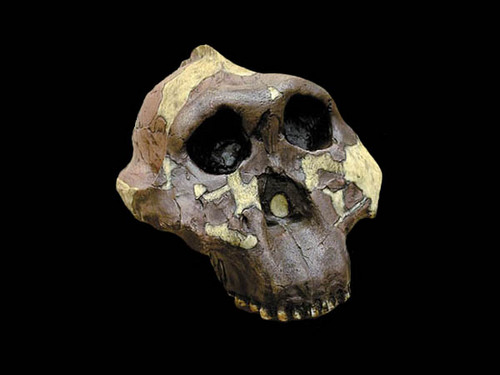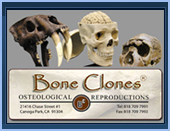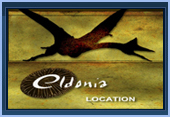일반명 : 오스트랄로피테쿠스 보이세이
학명: Australopithecus boisei (OH 5)
시대 : 1.8 million-year-old
발견지역 : Olduvai Gorge, Tanzania
발견시기 : 1959
발견자 : Mary Leakey
1.8 MYA. The Australopithecus boisei Skull, NUTCRACKER MAN, is the most famous fossil from
Written by C. David Kreger
Introduction
The discovery of the specimen OH 5 ("Zinj") in 1959, by Mary Leakey, was a watershed in the history of paleoanthropology. The find vindicated Louis and Mary Leakey's work at Olduvai (which had been relatively fruitless over the previous 30 years), which led to renewed research interest in the area, added an important stage in a relatively sparse hominid lineage at the time, and also was important in focusing attention on multidisciplinary research. The fairly complete cranium (sans mandible) was given the species name Zinjanthropus boisei by Louis Leakey, which eventually became known as Australopithecus boisei. However, Zinjanthropus lives on in the well known nickname of OH 5, "Zinj".
Specimens attributed to A. boisei have been found mostly in
Diagnostic Features
The most striking feature of the A. boisei specimens is the degree of megadontia. This species has the absolute largest teeth found in any hominid group, with teeth similar in size to gorillas (who weigh as much as 10 times as much). They are often referred to as hyper-robust due to the massive postcanine megadontia. The features of boisei are best described in relation to the other "robusts" (including aethiopicus), since this best shows some of the features that exclude aethiopicus from the "robust" lineage in favor of africanus. Features that line up boisei as a descendent of africanus rather than aethiopicus include:
- The face is more vertically set, more orthognathic (variability in this trait).
- There is anterior teeth reduction.
- There is a continued increase in postcanine teeth size.
- There is a larger cranial capacity (500-550 cc).
- The sagittal crest is on the mid-brain case, not the posterior.
Since aethiopicus and africanus are contemporary, only one can be the ancestor to boisei, and africanus seems a more likely scenario. Perhaps more importantly, boisei shares unique traits with later species that undoubtedly link it with africanus (who is likely the ancestor of these later species). Features that link boisei with A. robustus (and possibly early Homo) include:
- Some structural brain differences reflected in endocasts, such as: A) greater frontal lobe breadth B) expanded parietal cortex C) increased cerebral height (high cerebral to cerebellar height) D) cerebellar lobes "tucked in" and not projecting laterally or posteriorly.
- Increased flexion of the cranial base.
- Shortening of the base and decrease in the angle of the petrous pyramids.
- More anterior foramen magnum position.
- Deeper mandibular fossa with well-delineated, projecting, articular eminence.
- Nearly horizontal orientation of nuchal plane.
- Expanded height of occipital plane of the occiput, with a concomitant low inion position.
- Decreased facial prognathism, especially subnasal.
- Shortened distance between the tooth row and the mandibular fossa.
- Reduced posterior component of temporalis muscle.
- Weakly developed or absence of pneumatized bone in the temporal squama.
The hyper-robusticity of boisei did not extend to their body size, as they are approximately only 10% larger than africanus (and a whopping 60% smaller than aethiopicus). A. boisei also shows a progression toward a more modern form relative to its ancestors, as sexual dimorphism is reduced (with males 1.3 time larger than females).
A. boisei was very important in clearing up a controversy that raged in the 1960s over the idea of the "Single Species Hypothesis" (championed by
It is now generally accepted that (in the instance of the South African australopithecines) there are two separate species, and not a single sexually dimorphic one. While some claim that this was the "death" of the single species hypothesis, it really only showed that two different species could be contemporary, and modified single species concept (one highly variable population concept) is alive and well, and difficult to prove or disprove, which guarantees it will be around and debated for a long time to come.
Conclusions
Australopithecus boisei is an important species both in the history of paleoanthropological research and in constructing the phylogeny of the hominid lines. The features it shares or lacks with contemporary and earlier species makes relatively clear the relative phylogeny of the "robust" australopithecines. It also is present at a time when stone tools become much more common, and may have even made and used some. In the end, however, it seems that boisei became too specialized, and died with climatic and/or environmental shifts.
Bibliography
Aiello, L., and C. Dean. 1990. An Introduction to Human Evolutionary Anatomy.
Bromage, T.G. 1992. "Faces from the past." In New Scientist, Jan. 11, pp. 38-41.
Holloway, R.L. 1988. "'Robust' australopithecine brain endocasts: Some preliminary observations." In Evolutionary History of the "Robust" Australopithecine, ed. by F.E. Grine, pp. 97-105.
Johanson, D., and B. Edgar. 1996. From Lucy to Language.
Jones, S., R. Martin, and D. Pilbeam, eds. 1992. The Cambridge Encyclopedia of Human Evolution.
Leakey, L.S.B. 1959. "A new fossil skull from Olduvai." In Nature, vol. 184, pp. 491-493.
Leakey, L.S.B. 1960. "Recent discoveries at
Leakey, R.E. 1970. "New hominid remains and early artifacts from
Leakey, R.E. 1971. "Further evidence of lower Pleistocene hominids from East Rudolf,
McHenry, H. 1994. "Behavioral ecological implications of early hominid body size." In Journal of Human Evolution, vol. 27, pp. 77-87.
Rak, Y. 1978. "The functional significance of the squamosal suture in Australopithecus boisei." In American Journal of Physical Anthropology, vol. 49, pp. 71-78.
Rak, Y. 1988. "On variation in the masticatory system of Australopithecus boisei." In Evolutionary History of the "Robust" Australopithecine, ed. by F.E. Grine, pp. 193-198.
Skelton, R.R., and H.M. McHenry. 1992. "Evolutionary relationships among early hominids." In Journal of Human Evolution, vol. 23, pp. 309-349.
Tobias, P.V. 1968. The Cranium and Maxillary Dentition of Australopithecus ("Zinjanthropus") boisei.
Tobias, P.V. 1988. "Numerous apparently synapomorphic features in Australopithecus robustus, Australopithecus boisei, and Homo habilis: Support for the Skelton-McHenry-Drawhorn hypothesis." In Evolutionary History of the "Robust" Australopithecine, ed. by F.E. Grine, pp. 293-308.
Wolpoff, M. 1999. Paleoanthropology. second edition.
Wood, B.A. 1988. "Are 'robust' australopithecines a monophyletic group?" In Evolutionary History of the "Robust" Australopithecine, ed. by F.E. Grine, pp. 269-284.
Wood, B.A., C. Wood, and L. Konigsbergt. 1994. "Paranthropus boisei: An example of evolutionary stasis?" In American Journal of Physical Anthropology, vol. 95, no. 2, pp. 117-136.










































 수량을 선택해주세요.
수량을 선택해주세요.





































